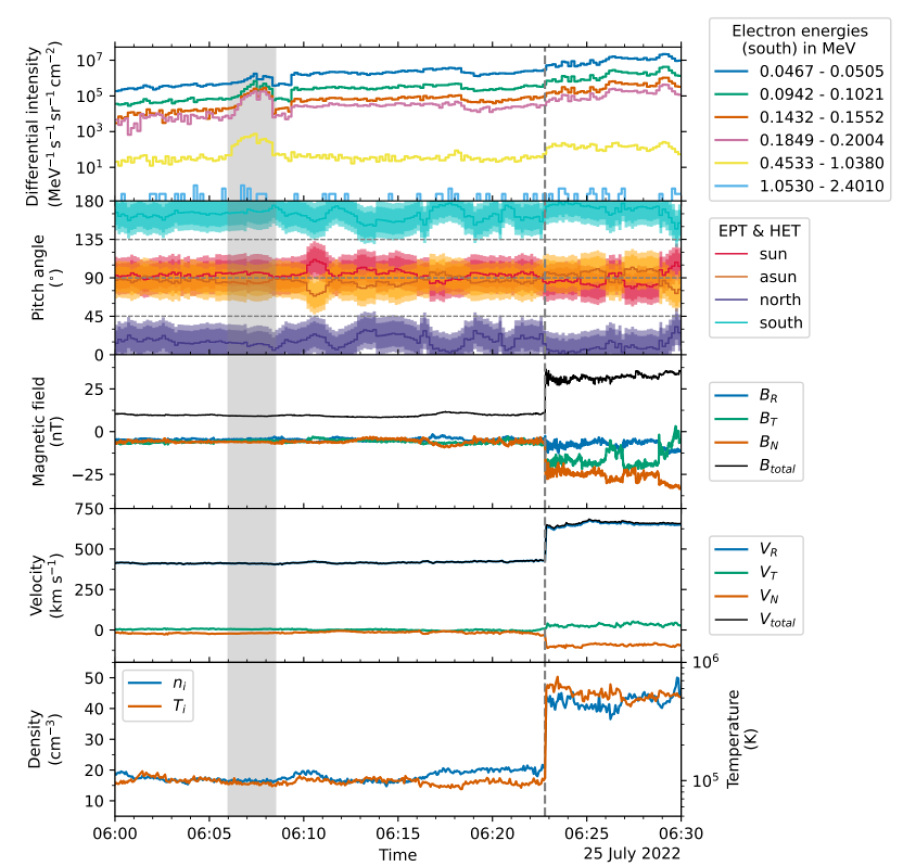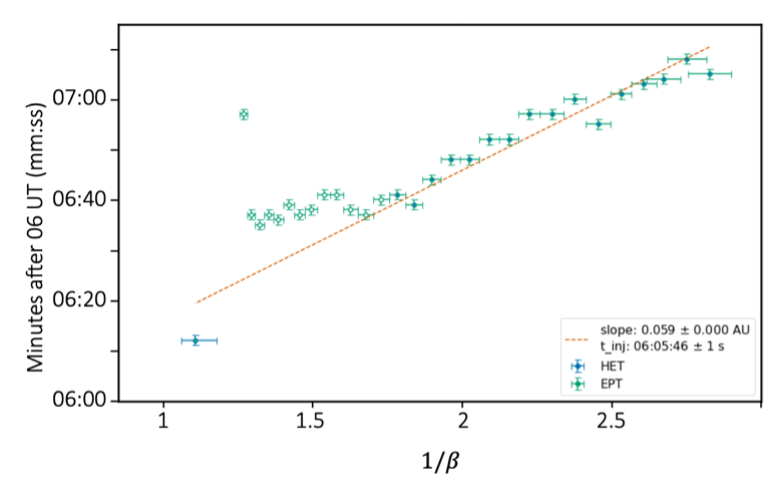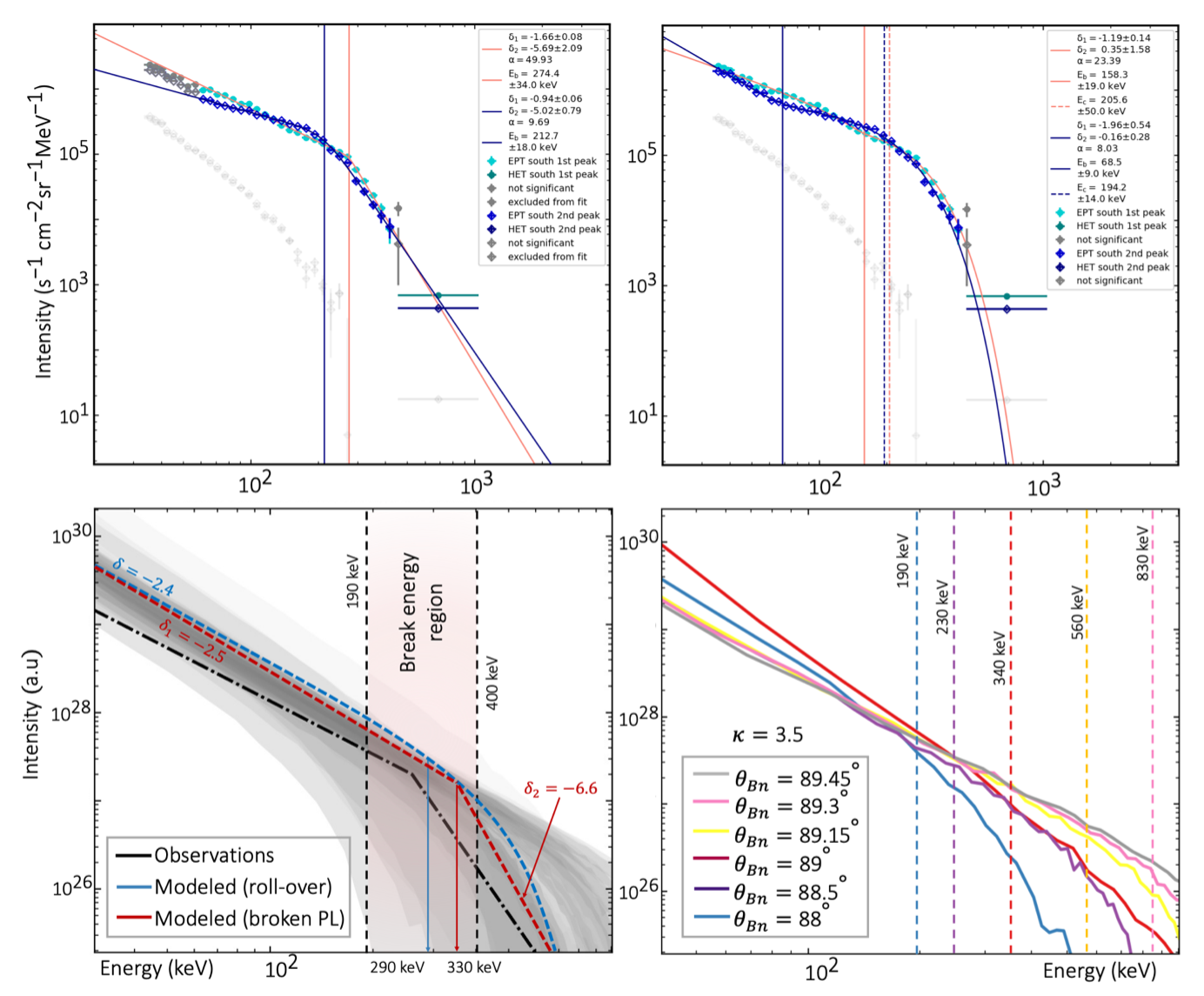Science nugget: Relativistic electrons accelerated by an interplanetary shock wave - Solar Orbiter
Relativistic electrons accelerated by an interplanetary shock wave
(Solar Orbiter Nugget #27 by I. C. Jebaraj1, N. Dresing1, V. Krasnoselskikh2,3, O. Agapitov3, J. Gieseler1, D. Trotta4, N. Wijsen5, A. Larosa6, A. Kouloumvakos7, C. Palmroos1, A. Dimmock8, A. Kolhoff9, P. Kühl9, S. Fleth9, A. Fedeli1, S. Valkila1, D. Lario10, Yu. V. Khotyaintsev8, R. Vainio1)
Introduction
Interplanetary (IP) shock waves, often triggered by solar phenomena like coronal mass ejections (CMEs), are efficient accelerators of ions and, in rare instances, electrons [1]. Our study presents the first-ever observations of field-aligned beams (FABs) of electrons reaching relativistic energies ahead of an IP shock. These measurements were made possible by the Energetic Particle Detector (EPD) [2] on the Solar Orbiter (SolO) [3], which boasts a high-resolution capture rate of one second. Electron acceleration, especially to relativistic speeds, is challenging due to their significantly lighter mass compared to protons and the limitations of current instruments [4]. While the acceleration of sub-relativistic electrons, usually associated with type II radio emissions, is well-acknowledged, the process for accelerating electrons to relativistic levels is not yet fully understood. In this research, we explore the characteristics of the observed FABs by SolO and propose a potential acceleration mechanism for such beams of relativistic electrons.
Solar Orbiter Observations
On 25 July 2022, SolO detected an in situ IP shock wave, associated with a C1 solar flare and CME from 23 July. Notably, during the shock crossing, the spacecraft observed upstream field-aligned beams of relativistic electrons (30 keV up to ~1 MeV), highlighted in the top panel of Fig. 1, as part of an energetic storm particle (ESP) event for electrons. The beam was observed ~14 minutes prior to the shock crossing. The pitch angle (PA) coverage (Fig. 1 second panel) during this time was notably stable due to a steady magnetic field vector. The FAB was observed along the south-facing detector, and the magnetic field's north-south orientation meant that south-facing SolO/EPD observed anti-sunward propagating FABs.

Figure 1: Overview of the in situ shock and energetic electrons observed by Solar Orbiter on 25 July 2022. The arrival of the shock at 06:22:47 is indicated by the vertical gray dashed line in all panels. The first panel shows the differential intensities of energetic electrons observed by the south telescopes of EPT and HET (covering a stable pitch angle of 180° throughout the shown period). The upstream FABs are observed between 06:06:00 and 06:08:30 UT, and are indicated by the gray shaded region. The second panel presents the pitch-angle coverage for the different viewing directions of EPT and HET, where the gradients in color indicate the different telescope openings of EPD/EPT (smaller) and EPD/HET (larger). The third and fourth panels show the components of the magnetic field, and bulk flow velocity, while the fifth panel presents the ion number density and proton temperature.
Origin of the beam
Based on the assumption of simultaneous electron injection at all energies, we performed a velocity dispersion analysis (VDA) [5] on the FAB to determine their injection time and path length. Results shown in Fig. 2 suggest the electrons were accelerated about 13 solar radii from the observer and injected at 06:05:46 UT, implying the beam's origin was a distant part of the shock rather than local acceleration. The analysis couldn't include the lowest energy levels because the Sun-facing detector, aligned perpendicular to the magnetic field, made the low-energy STEP detector unusable for this purpose. Nevertheless, using the results from VDA, the observation of two Langmuir wave packets four minutes following the beam's detection lets us infer that the beam attained energies of a few keV. The presence of Langmuir waves also confirms the remote origin of the beam, as the electrons must have propagated a distance corresponding to their relaxation length [6,7].

Figure 2: VDA based on onset times of Solar Orbiter EPT and HET electron channels. The horizontal axis shows the inverse of the average unit-less speed of electrons, as observed in each channel. The vertical axis presents the determined onset time for each energy channel. Onset times observed by EPT (HET) are marked in green (blue). The horizontal error bars represent the width of the energy channels, and the vertical error bars represent the time resolution used to determine the onsets (1 second). The orange line represents the linear fit to the first 16 energy channels of EPT and the first channel of HET, respectively. The onset times that are not considered in the fit have a white middle on the data points.
Characteristics of the electron beam
In our study, we constructed peak-intensity spectra across all energy channels to analyze the generation and propagation of FAB, which had two distinct peaks within it. We used two different fits, a single power-law with a roll-over, and a broken power-law [8]. The top panels of Fig. 3 display the spectra of both peaks, derived from EPT and HET south-facing telescopes with a 15-second resolution, after subtracting background and correcting for contamination. The top right panel of Fig. 3 fits both peaks across EPT channels, including an ankle-like feature below 100 keV, more pronounced in the second peak's spectrum. Both fits show a similar exponential rollover at higher energies. Excluding the ankle, results in a broken power-law fit (shown in the top left panel of Fig. 3), which, while aligning better with HET data is unclear due to the low statistics at higher energy channels of HET. All spectral fits yield similar cutoff energies (Ec~200 keV), but slightly different break energies (Eb~200-300 keV). The second peak shows a more pronounced ankle around ~70 keV. Spectral indices differ, for the first peak, δ = −1.19 ± 0.14 (right panel) and δ1 = −1.66 ± 0.08, δ2 = −5.69 ± 2.09 (left panel); for the second peak, δ = −1.96 ± 0.54 (right panel) and δ1 = −0.94 ± 0.06, δ2 = −5.02 ± 0.79 (left panel).

Figure 3: Comparison of the peak-intensity electron spectra: observation (top) vs. model (bottom). In the top two panels the points in cyan signify the first peak, while points in blue denote the second peak. The corresponding fits are indicated by orange for the first peak and blue for the second. The background that has been subtracted from each energy channel is represented by points in gray. Top left: Broken power-law fits applied to both peaks. Top right: Broken power-law fits with an exponential roll-over (or cutoff) for the two peaks. Bottom left: Ensemble of runs indicated by the gray shaded region with varying κ ~ 3−4 and θBn ~ 87° − 89.5°. A single power-law fit and exponential roll-over (blue dashed line), and a broken power-law fit (red dashed line) are shown for the modeled mean. The fit for the first peak from top left panel is illustrated by the black dash-dotted line. The mean cut-off (Ec) and break energies (Eb) of the ensemble and its standard deviation are also shown. Bottom right: Modeled results using κ ~ 3.5 for different θBn (88° − 89.5°). The corresponding break energies are indicated by the vertical dashed lines.
A simple mechanism for their acceleration
Our analysis suggests a change in electron acceleration efficiency between 200 and 300 keV. We applied a simplified "relativistic" fast-Fermi model, effective for electrons due to their small gyration radius [9]. We modeled the acceleration with a kappa distribution (κ = 3-4) for the electron source, common upstream of Earth's bow shock. We also assumed a source with near-perpendicular geometry (θBn = 85° – 89.9°) and a strong overshoot magnetic field (Bmax = 70 nT) enhancing electron reflection. Considering a near-perpendicular shock’s relativistic speeds in the Hoffmann-Teller frame and the Lorentz factor (gamma) >1 for electrons, a relativistic approach is necessary.
Our semi-analytical results, shown in Fig. 3's bottom panels, fit well with both a broken power-law and a power-law with an exponential roll-over, aligning closely with observational data, including the energy range for both Eb and Ec. The shock geometry, a crucial model parameter, influences the maximum energy and both Eb and Ec, while the κ value affects the spectral slope. The source κ distribution's nature as a power-law with an exponential roll-over [10] supports these findings. The relativistic fast-Fermi mechanism, a single reflection process, efficiently produces dilute beams of instantaneously accelerated electrons at near-perpendicular shocks. To explain a broken power-law formation, multiple reflections or a stochastic process must be considered. If the broken power-law better fits the observations, then electrons in the FAB up to the break energy might be accelerated by fast-Fermi, with a subset entering a stochastic regime at higher energies but with decreasing efficiency.
The observed Eb above 200 keV differs from previously noted breaks at 30-60 keV due to Langmuir wave growth and pitch-angle scattering induced breaks around ~120 keV. Since Langmuir waves in our study were linked with electrons of a few keV and the 13 solar radii distance seems too short for pitch-angle scattering related breaks, we attribute the ~200 keV change primarily to acceleration processes.
This study has been published in Immanuel C. Jebaraj, et al. 2023, Astronomy & Astrophysics, 680, L7 https://doi.org/10.1051/0004-6361/202348120
Acknowledgements
I.C.J and N.D. are grateful for support by the Academy of Finland (SHOCKSEE, grant No. 346902). We also acknowledge funding by the European Union’s Horizon 2020 research and innovation program under grant agreement No. 101004159 (SERPENTINE). I.C.J acknowledges support from ISSI as part of the visiting scientist program. I.C.J, V.K, and O.V.A. acknowledge support from the International Space Science Institute (ISSI) in Bern, through ISSI International Team project number 23–575, “Collisionless Shock as a Self-Regulatory System”. V.K. acknowledges financial support from CNES through grants, “Parker Solar Probe”, and “Solar Orbiter”. V.K., and O.V.A. were supported by NASA grants 80NSSC20K0697 and 80NSSC21K1770. O.V.A was partially supported by NSF grant number 1914670, NASA’s Living with a Star (LWS) program (contract 80NSSC20K0218), and NASA grants contracts 80NNSC19K0848, 80NSSC22K0433, 80NSSC22K0522. A.L. is supported by STFC Consolidated Grant ST/T00018X/1. A.K. acknowledges financial support from NASA NNN06AA01C (SO-SIS Phase-E, PSP EPI-Lo) contract. N.W. acknowledges support from the Research Foundation – Flanders (FWO-Vlaanderen, fellowship no. 1184319N). D.L. acknowledges support from NASA Living With a Star (LWS) program NNH19ZDA001N-LWS, and the Goddard Space Flight Center Heliophysics Innovation Fund (HIF) program.
Affiliations
1 Department of Physics and Astronomy, University of Turku, 20500 Turku, Finland
2 LPC2E/CNRS, UMR 7328, 3A Avenue de la Recherche Scientifique, Orléans, France
3 Space Sciences Laboratory, University of California, Berkeley, CA, USA
4 The Blackett Laboratory, Department of Physics, Imperial College London, London, UK
5 Center for mathematical Plasma Astrophysics, Department of Mathematics, KU Leuven, Celestijnenlaan 200B, 3001 Leuven, Belgium
6 Queen Mary University of London, School of Physics and Astronomy, London, UK
7 The Johns Hopkins University Applied Physics Laboratory, Laurel, MD, 20723 USA
8 Swedish Institute of Space Physics, PO Box 537 751 21 Uppsala, Sweden
9 Institute of Experimental & applied Physics, Kiel University, 24118 Kiel, Germany
10 Heliophysics Science Division, NASA Goddard Space Flight Center, Greenbelt, MD, 20771 USA
References
[1] Talebpour Sheshvan, N., Dresing, N., Vainio, R., Afanasiev, A., & Morosan, D. E. 2023, A&A, 674, A133. https://doi.org/10.1051/0004-6361/202345908
[2] Rodríguez-Pacheco, J., Wimmer-Schweingruber, R. F., Mason, G. M., et al. 2020, A&A, 642, A7. https://doi.org/10.1051/0004-6361/201935287
[3] Müller, D., Marsden, R. G., Cyr, O. C., & Gilbert, H. R., 2013, Sol. Phys., 285, 25 https://doi.org/10.1007/s11207-012-0085-7
[4] Lembege, B., Giacalone, J., Scholer, M., et al. 2004, Space Sci. Rev., 110, 161 https://doi.org/10.1023/B:SPAC.0000023372.12232.b7
[5] Vainio, R., Valtonen, E., Heber, B., et al. 2013, J. Space Weather Space Clim., 3, A12 https://doi.org/10.1051/swsc/2013030
[6] Ryutov, D. D. 1969, Sov. J. Exp. Theoretical Phys., 30, 131
[7] Voshchepynets, A., Krasnoselskikh, V., Artemyev, A., & Volokitin, A. 2015, ApJ, 807, 38 https://doi.org/10.1088/0004-637X/807/1/38
[8] Dresing, N., Effenberger, F., Gómez-Herrero, R., et al. 2020, ApJ, 889, 143 https://doi.org/10.3847/1538-4357/ab64e5
[9] Leroy, M. M., & Mangeney, A. 1984, Ann. Geophys., 2, 449
[10] Oka, M., Birn, J., Battaglia, M., et al. 2018, Space Sci. Rev., 214, 82 https://doi.org/10.1007/s11214-018-0515-4
- Removed a total of (32) style text-align:left;
- Removed a total of (3) style margin:0;
Nuggets archive
2025
09/04/2025: Bursty acceleration and 3D trajectories of electrons in a solar flare
02/04/2025: Picoflare jets in the coronal holes and their link to the solar wind
19/03/2025: Radial dependence of solar energetic particle peak fluxes and fluences
12/03/2025: Analysis of solar eruptions deflecting in the low corona
05/03/2025: Propagation of particles inside a magnetic cloud: Solar Orbiter insights
19/02/2025: Rotation motions and signatures of the Alfvén waves in a fan-spine topology
12/02/2025: 'Sun'day everyday: 2 years of Solar Orbiter science nuggets that shed light on some of our star's mysteries
22/01/2025: Velocity field in the solar granulation from two-vantage points
15/01/2025: First joint X-ray solar microflare observations with NuSTAR and Solar Orbiter/STIX
2024
18/12/2024: Shocks in tandem : Solar Orbiter observes a fully formed forward-reverse shock pair in the inner heliosphere
11/12/2024: High-energy insights from an escaping coronal mass ejection
04/12/2024: Investigation of Venus plasma tail using the Solar Orbiter, Parker Solar Probe and Bepi Colombo flybys
27/11/2024: Testing the Flux Expansion Factor – Solar Wind Speed Relation with Solar Orbiter data
20/11/2024:The role of small scale EUV brightenings in the quiet Sun coronal heating
13/11/2024: Improved Insights from the Suprathermal Ion Spectrograph on Solar Orbiter
30/10/2024: Temporally resolved Type III solar radio bursts in the frequency range 3-13 MHz
23/10/2024: Resolving proton and alpha beams for improved understanding of plasma kinetics: SWA-PAS observations
25/09/2024: All microflares that accelerate electrons to high-energies are rooted in sunspots
25/09/2024: Connecting Solar Orbiter and L1 measurements of mesoscale solar wind structures to their coronal source using the Adapt-WSA model
18/09/2024: Modelling the global structure of a coronal mass ejection observed by Solar Orbiter and Parker Solar Probe
28/08/2024: Coordinated observations with the Swedish 1m Solar Telescope and Solar Orbiter
21/08/2024: Multi-source connectivity drives heliospheric solar wind variability
14/08/2024: Composition Mosaics from March 2022
19/06/2024: Coordinated Coronal and Heliospheric Observations During the 2024 Total Solar Eclipse
22/05/2024: Real time space weather prediction with Solar Orbiter
15/05/2024: Hard X ray and microwave pulsations: a signature of the flare energy release process
01/02/2024: Relativistic electrons accelerated by an interplanetary shock wave
11/01/2024: Modelling Two Consecutive Energetic Storm Particle Events observed by Solar Orbiter
2023
14/12/2023: Understanding STIX hard X-ray source motions using field extrapolations
16/11/2023: EUI data reveal a "steady" mode of coronal heating
09/11/2023: A new solution to the ambiguity problem
02/11/2023: Solar Orbiter and Parker Solar Probe jointly take a step forward in understanding coronal heating
25/10/2023: Observations of mini coronal dimmings caused by small-scale eruptions in the quiet Sun
18/10/2023: Fleeting small-scale surface magnetic fields build the quiet-Sun corona
27/09/2023: Solar Orbiter reveals non-field-aligned solar wind proton beams and its role in wave growth activities
20/09/2023: Polarisation of decayless kink oscillations of solar coronal loops
23/08/2023: A sharp EUI and SPICE look into the EUV variability and fine-scale structure associated with coronal rain
02/08/2023: Solar Flare Hard Xrays from the anchor points of an eruptive filament
28/06/2023: 3He-rich solar energetic particle events observed close to the Sun on Solar Orbiter
14/06/2023: Observational Evidence of S-web Source of Slow Solar Wind
31/05/2023: An interesting interplanetary shock
24/05/2023: High-resolution imaging of coronal mass ejections from SoloHI
17/05/2023: Direct assessment of far-side helioseismology using SO/PHI magnetograms
10/05/2023: Measuring the nascent solar wind outflow velocities via the doppler dimming technique
26/04/2023: Imaging and spectroscopic observations of EUV brightenings using SPICE and EUI on board Solar Orbiter
19/04/2023: Hot X-ray onset observations in solar flares with Solar Orbiter/STIX
12/04/2023: Multi-scale structure and composition of ICME prominence material from the Solar Wind Analyser suite
22/03/2023: Langmuir waves associated with magnetic holes in the solar wind
15/03/2023: Radial dependence of the peak intensity of solar energetic electron events in the inner heliosphere
08/03/2023: New insights about EUV brightenings in the quiet sun corona from the Extreme Ultraviolet Imager








































 Sign in
Sign in
 Science & Technology
Science & Technology